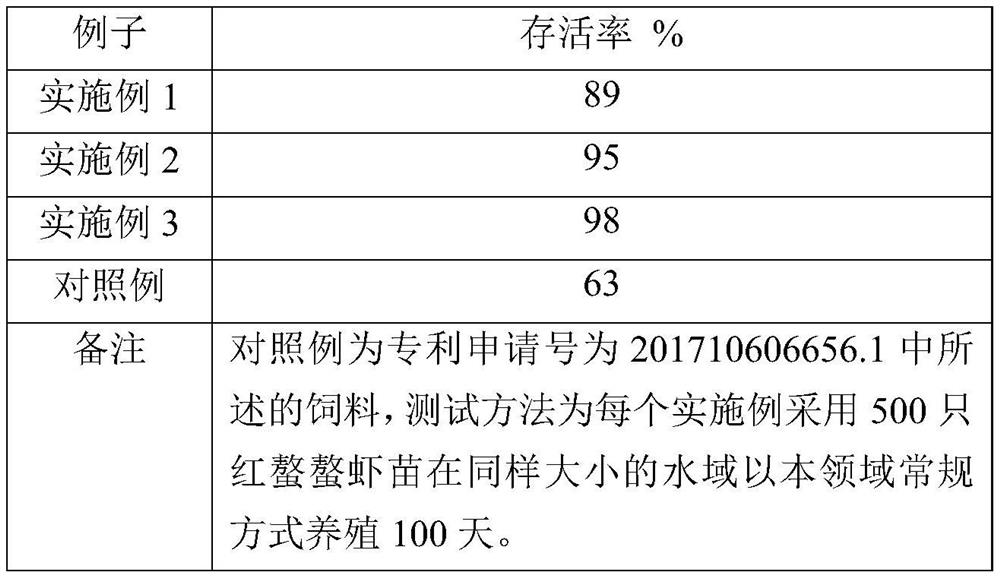Bottom material of cherax quadricarinatus
A red-clawed crayfish and base material technology, which is applied to animal feed, animal feed, bacteria used in food preparation, etc., can solve problems such as the impact on the survival rate of red-clawed crayfish
- Summary
- Abstract
- Description
- Claims
- Application Information
AI Technical Summary
Problems solved by technology
Method used
Image
Examples
Embodiment 1
[0028] A base material for red-clawed crayfish is mainly prepared from the following raw materials in parts by weight:
[0029] Bagasse 80-100 parts, wheat straw 40-60 parts, corn cob 70-80 parts, willow silk 30-50 parts, shell powder 10-20 parts, tea bran 20-30 parts, humic acid 50-60 parts, ore 30-40 parts of substances, 5-20 parts of microbial flora, 10-18 parts of dandelion and 8-16 parts of astragalus; the microbial flora includes one of lactic acid bacteria, photosynthetic bacteria and yeast; the lactic acid bacteria can be Lactobacillus plantarum.
[0030] Specifically, photosynthetic bacteria include Pseudomonas marsh.
[0031] Specifically, the yeast can be Saccharomyces cerevisiae.
[0032] The technical solution of this embodiment has at least the following technical effects or advantages:
[0033]The above technical scheme, due to the use of natural plant fibers such as bagasse, wheat straw, corn cob and willow silk, combined with a series of technical means such...
Embodiment 2
[0035] A base material for red-clawed crayfish is mainly prepared from the following raw materials in parts by weight:
[0036] 90 parts of bagasse, 50 parts of wheat straw, 75 parts of corn cob, 40 parts of willow silk, 15 parts of shell powder, 25 parts of tea bran, 55 parts of humic acid, 35 parts of minerals, 13 parts of microbial flora, 14 parts of dandelion and Astragalus 12 parts.
[0037] Specifically, the microbial flora includes lactic acid bacteria, photosynthetic bacteria and yeast.
[0038] Specifically, the lactic acid bacteria include Lactobacillus plantarum and Lactobacillus casei; the photosynthetic bacteria include Rhodomonocytosis palustris and Rhodobacter sphaericus.
[0039] The technical solution of this embodiment has at least the following technical effects or advantages:
[0040] The above technical scheme, due to the use of natural plant fibers such as bagasse, wheat straw, corn cob and willow silk, combined with a series of technical means such as ...
Embodiment 3
[0043] A base material for red-clawed crayfish is mainly prepared from the following raw materials in parts by weight:
[0044] 100 parts of bagasse, 60 parts of wheat straw, 80 parts of corn cob, 50 parts of willow silk, 20 parts of shell powder, 30 parts of tea bran, 60 parts of humic acid, 40 parts of minerals, 20 parts of microbial flora, 18 parts of dandelion and 16 parts of Radix Astragali; the microbial flora includes various types of lactic acid bacteria, photosynthetic bacteria and yeast; the lactic acid bacteria can be Lactobacillus plantarum and Lactobacillus casei.
[0045] Specifically, the photosynthetic bacteria include Rhodopseudomonas palustris and Rhodobacter musculus.
[0046] Specifically, the yeast is Saccharomyces cerevisiae.
[0047] The technical solution of this embodiment has at least the following technical effects or advantages:
[0048] The above technical scheme, due to the use of natural plant fibers such as bagasse, wheat straw, corn cob and w...
PUM
 Login to View More
Login to View More Abstract
Description
Claims
Application Information
 Login to View More
Login to View More - R&D
- Intellectual Property
- Life Sciences
- Materials
- Tech Scout
- Unparalleled Data Quality
- Higher Quality Content
- 60% Fewer Hallucinations
Browse by: Latest US Patents, China's latest patents, Technical Efficacy Thesaurus, Application Domain, Technology Topic, Popular Technical Reports.
© 2025 PatSnap. All rights reserved.Legal|Privacy policy|Modern Slavery Act Transparency Statement|Sitemap|About US| Contact US: help@patsnap.com

